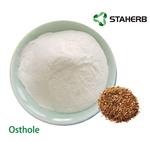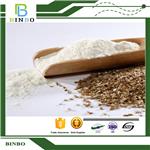- Osthole
-

- $0.00 / 1KG
-
2025-04-27
- CAS:484-12-8
- Min. Order: 1KG
- Purity: 10%-98% HPLC
- Supply Ability: 1000KG`
- Osthole
-

- $150.00 / 1kg
-
2025-04-25
- CAS:484-12-8
- Min. Order: 1kg
- Purity: 99%
- Supply Ability: 500kg
- Osthole
-

- $0.00 / 1kg
-
2025-04-02
- CAS:484-12-8
- Min. Order: 1kg
- Purity: 98%
- Supply Ability: 1000 kg
|
| | Osthole Chemical Properties |
| Melting point | 83-84°C | | Boiling point | 347.2°C (rough estimate) | | density | 1.1263 (rough estimate) | | refractive index | 1.5570 (estimate) | | storage temp. | Sealed in dry,2-8°C | | solubility | methanol: soluble10mg/mL, clear, colorless | | form | powder | | color | white | | Odor | at 100.00 %. dry musty herbal | | Odor Type | dry | | Water Solubility | 12mg/L(25 ºC) | | λmax | 322nm(MeOH)(lit.) | | Merck | 14,6895 | | InChIKey | MBRLOUHOWLUMFF-UHFFFAOYSA-N | | LogP | 3.686 (est) | | CAS DataBase Reference | 484-12-8(CAS DataBase Reference) | | NIST Chemistry Reference | Osthole(484-12-8) |
| | Osthole Usage And Synthesis |
| Plant extracts | Osthole is a substance extracted from the fruit of the annual Umbelliferae plant Fructus Cnidii. It appears as yellow-green to white crystalline powder. It is insoluble in cold water and petroleum ether, easily soluble in acetone, methanol, ethanol, chloroform and ethyl acetate and soluble in boiling petroleum ether. It has various effects including antispasmodic, hypotensive, anti-arrhythmic, enhancing immune function and broad-spectrum antimicrobial effect. It is clinically mainly used for the treatment of men impotence, scrotal wet itchy, women prurUus Yulvae and cold uterus and infertility, rheumatism, scabies, eczema and trichomonas vaginitis. Osthole can also be used to make field insecticides, fungicides with contact killing action being the primary effect and stomach poisoning being the auxiliary effect. The drug liquid can be absorbed through body surface and enter into the body and further act on the nervous system of pests, causing the non-functional muscle contraction of the pests and eventually leading to death due to energy exhaustion. It has a relative excellent contact-killing effect on various kinds of pests such as cabbage caterpillar, tea looper, cotton bollworm, beet armyworm and any kinds of aphids.
| | Physical and Chemical Properties | Osthole belongs to coumarin compounds. It is prismatic-like crystals (diethyl ether) and needle-like crystals (Ethanol) with the melting point being 83~84 ℃ and the boiling point being 145~150 ℃. It is soluble in alkaline solution, methanol, ethanol, chloroform, acetone, ethyl acetate, and boiling petroleum ether but insoluble in water and petroleum ether.
| | Pharmacological effects | Osthole has various kinds of effects of antispasmodic, hypotensive, anti-arrhythmic and enhancing immune function and broad-spectrum antimicrobial effect. Osthole can not only have efficacy such as anti-hypertensive, anti-arrhythmic, anti-inflammatory, anti-tumor and anti-osteoporosis effect, but can also act as a new type of biological pesticides with significant efficacy in treating pests and plant pathogens.
The above information is edited by the chemicalbook of Dai Xiongfeng.
| | Botanical insecticides | Osthole is a class of natural coumarin compound which had been initially extracted from Umbelliferae plants. The dried ripe fruit of Fructus Cnidii in the Umbelliferae plant, Cnidium monnieri has a relative high content, hence obtaining the name. Related research has shown that Osthole is also presented in other kinds of plants, including Umbelliferae including Angelica, Archangelica Hoffm and Cnidium as well as rutaceous plant such as citrus, clausena, Limonia acidissima and Haplophyllum A. Juss. In addition, it is also distributed in a few species of Asteraceae and legumes.
Osthole has its chemical name being 7-methoxy-8-isopenteylcoumarin with the core structure consisting of benzene and pyrone ring. As a member of coumarins compounds, Osthole, in addition to containing the core structure of coumarin, also has isopentenyl structure. Compound containing isopentenyl structure, as a phytoalexin, plays an important role in fighting against disease.
Osthole, as a kind of botanical pesticide, has contact-killing effect being the primary effect and stomach poisoning effect being the auxiliary effect. The drug liquid can be absorbed into the insect body through body surface and acts on the nervous system of pests, causing non-functional muscle contraction and final death due to energy exhaustion. Indoor activity virulence tests have showed that it has a higher activity against Pieris rapae (LD50 is 6.2258 mg/kg). It is demonstrated through the field efficacy trials that it has excellent efficacy in the treatment of Pieris rapae of cruciferous vegetables and tea and tea looper caterpillar. The drug dosage for prevention and treatment of the Pieris rapae of cruciferous vegetables has the active ingredient be 4.8~7.2g/hm (equals to 80~120 mL per acre if converted to 0.4% Osthole cream commercialized product); the drug dosage against tea mites has the active ingredient be 6 to 7.2 g/hm (equals to 100~120 mL per acre if converted to 0.4% Osthole cream commercialized product). Apply the drug liquid at an amount of 50~75 kg per acre with uniform spray; the period of validity is about 7d. It is safe for crop within the dose range with no drug injury.
| | Description | Cnidium is a Chinese medicine which is used widely by traditional medicine doctors.
Cnidium has been recorded in almost all of the pharmaceutical monographs , including Shen Nong’s Classic Materia Medica, New Materia Medica, Compendium of Materia Medica, etc. Osthole is a major bioactivity compound of the Cnidium, which has the effect of dampness dispelling, insecticidal antipruritic,and aphrodisiac and is used for the treatment for pruritus and eczema, lumbago,kidney impotence, and infertility .
Osthole is derived from Umbelliferae and Rutaceae plants. Osthole is also distributed
in Asteraceae and Leguminosae plants. Osthole is present in 14 genera of Umbelliferae plants: danggui (Angelica L.), gudanggui (Archangelica Hoffm.), mianguoqin (Cachrys L.), shechuang (Cnidium Cusson), awei (Ferula L.), duhuo (Heracleum L.), yanfeng (Libanotis Hill), ouqin (Petroselinum Hill), qianhu (Peucedanum L.), huiqin (Pimpinella L.), liangshechuang (Selinum L.). Shuanchiqin (Prangos Lindl), xifengqin (Seseli L.), oufangfeng (Pastinaca L.). Osthole is present in 17 genera of Rutaceae plants: ganju (Citrus L.), huangpi (Clausena Burm. F.), xiangju (Feronia Correa), jupanmu (Flindersia R. Br.), niyunxiang (Haplophyllum A. Juss.), mizhuyu (Melicope J. R. and G. Forst.), xiaoyunmu (Micromelum Bl.), jiulixiang (Murraya Koenig ex L.), zhi (Poncirus Raf.), yinyu (Skimmia Thunb.), Limonia, Myrtopsis, Pentaceras, Phebalium, Pilocarpus, Thamnosma, Ticorea) . | | Physical properties | Appearance: white needlelike crystalline powder. Solubility: soluble in methanol.
Melting point: 83–84 °C. | | History | Cnidium is a Chinese medicine which is used widely by traditional medicine doctors.
Osthole was isolated in 1950 and then its chemical structure was determined
. Osthole can be extracted by solvent method, acid-base method,
ultrasound, and supercritical and other methods. The main methods for the separation
of osthole are recrystallization, chromatography, and so on. With the development
of modern pharmacological experimental methods and techniques, the
pharmacological effects of osthole have been discovered and developed. It is found
that osthole has many pharmacological activities such as anti-osteoporosis, antiplatelet
aggregation, antiviral, anti-mutation, anti-allergic reaction, and so on. In
recent years, it has been found that osthole has obvious antitumor activity. In addition,
osthole also has strong insecticidal and antifungal effects. In the future, osthole
is expected to be developed as a new kind of low-toxicity, high-efficiency, and lowresidue
pesticide. | | Uses | Osthole inhibits the PI3K/Akt pathway thus inhibiting insulin-like growth factor-1 (IGF-1)-induced epithelial-to-mesenchymal transition (EMT) in brain cancer. Osthole may be used in the treatment of Glioblastoma multiforme (GBM). | | Indications | Impotence, infertility, uterine cold, wet nose with low back pain, vulva eczema,
woman vulvae, trichomonas vaginitis | | Definition | ChEBI: A natural product found in Peucedanum ostruthium and Angelica pubescens. | | Pharmacology | 1. Osthole can enhance the non-specific immune function of mice.
2. Osthole exhibits protective effect on the heart and circulatory system. Osthole
can dilate blood vessels, reduce blood pressure, reduce blood lipid, and inhibit
the formation of venous thrombosis.
3. Osthole has a central sedative effect and can improve the learning and memory
function of mice.
4. Osthole presents the effect of relieving asthma by regulating the function of
hypothalamus-pituitary-adrenal cortex system.
5. Osthole has antiaging and antioxidant effects, which may be related to the
direct scavenging of oxygen free radicals.
6. Osthole reduces osteoporosis and bone resorption in ovariectomized rats and
increases bone mass. Osthole can effectively prevent osteoporosis in ovariectomized
rats, prevent bone loss, and maintain bone metabolism balance.
7. Osthole can relieve itching, which may be related to blocking the Ca2+ channel
of mast cells, decreasing the flow of Ca2+, and inhibiting the release of histamine
from mast cells.
8. Osthole is a noncompetitive antagonist of Ca2+, which can inhibit the smooth
muscle of the uterus. In addition, osthole has a certain androgen-like, estrogen-like
effect.
9. Osthole has anti-inflammatory effects on acute and chronic inflammation models,
and its anti-inflammatory mechanism is not through the pituitary-adrenal cortex system, but also with the synthesis of PGE. It may be possible to exert anti-inflammatory effects by enhancing non-specific immune function and/or anti-allergic reactions .
10. Accumulating experimental evidences have shown that osthole exhibited antiproliferative properties and induced apoptosis in various kinds of tumor cells.
Besides, osthole has broad-spectrum antibacterial and insecticidal effects. | | Clinical Use | In vitro and in vivo experimental results have revealed that osthole demonstrates
multiple pharmacological actions including neuroprotective, osteogenic, immunomodulatory,anticancer, hepatoprotective, cardiovascular protective, and antimicrobial activities. Osthole is expected to be used in the treatment of cardiovascular system, central nervous system, and immune system diseases. |
| | Osthole Preparation Products And Raw materials |
|